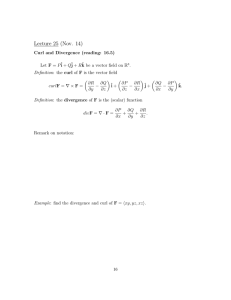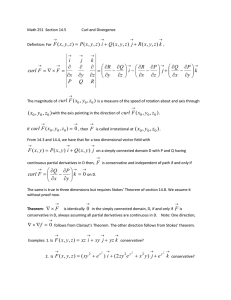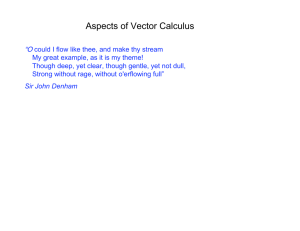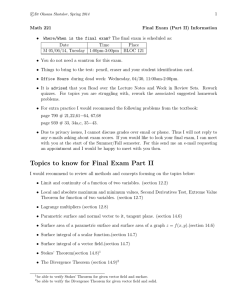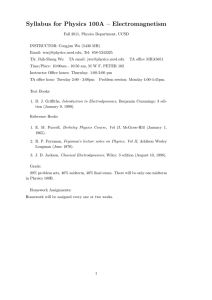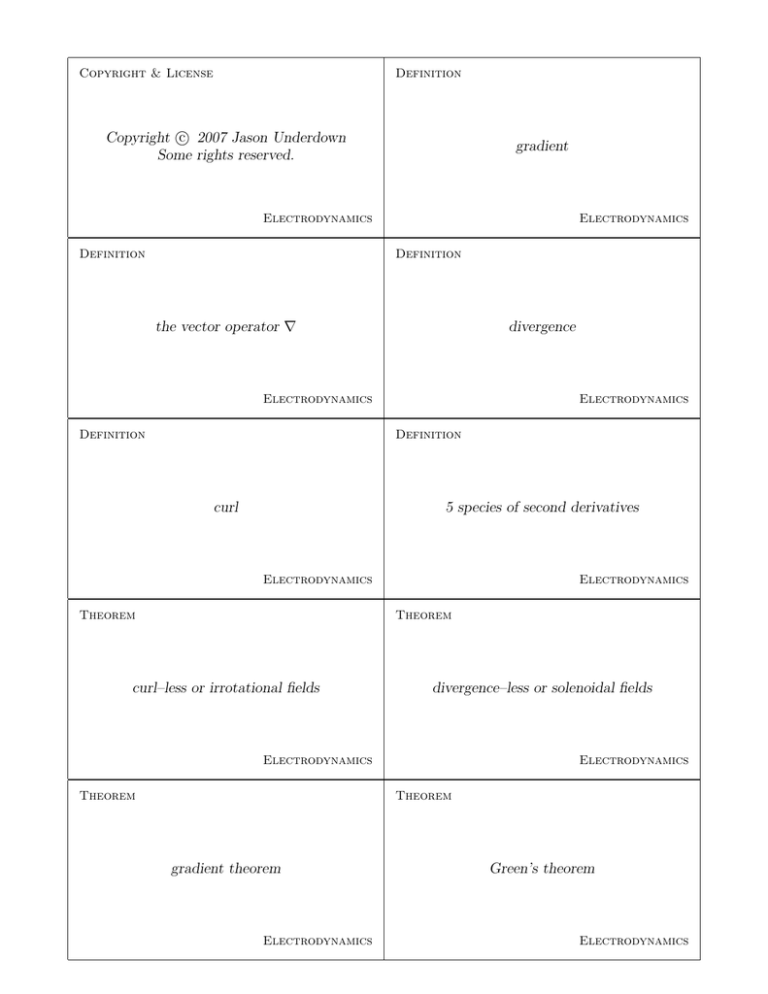
Definition
Copyright & License
c 2007 Jason Underdown
Copyright Some rights reserved.
gradient
Electrodynamics
Definition
Electrodynamics
Definition
the vector operator ∇
divergence
Electrodynamics
Definition
Electrodynamics
Definition
curl
5 species of second derivatives
Electrodynamics
Theorem
Electrodynamics
Theorem
curl–less or irrotational fields
divergence–less or solenoidal fields
Electrodynamics
Theorem
Electrodynamics
Theorem
gradient theorem
Electrodynamics
Green’s theorem
Electrodynamics
The gradient ∇T points in the direction of maximum
increase of the function T .
∇T ≡ x̂
∂T
∂T
∂T
+ ŷ
+ ẑ
∂x
∂y
∂z
The magnitude |∇T | is the slope along this direction.
∇·v
=
=
These flashcards and the accompanying LATEX source
code are licensed under a Creative Commons
Attribution–NonCommercial–ShareAlike 2.5 License.
For more information, see creativecommons.org. You
can contact the author at:
jasonu [remove-this] at physics dot utah dot edu
∂
∂
∂
+ ŷ
+ ẑ ) · (vx x̂ + vy ŷ + vz ẑ)
∂x
∂y
∂z
∂vx
∂vy
∂vz
+
+
∂x
∂y
∂z
(x̂
∇ ≡ x̂
∂
∂
∂
+ ŷ
+ ẑ
∂x
∂y
∂z
The divergence is a measure of how much the vector
function v spreads out from the point in question.
By applying ∇ twice we can construct five species of second
derivatives.
x̂
∂
∇ × v = ∂x
vx
2
1. divergence of a gradient ∇ · (∇T ) = ∇ (Laplacian)
2. curl of a gradient ∇ × (∇T ) = 0 (always)
3. gradient of a divergence ∇(∇ · v) (seldom occurs)
4. divergence of a curl ∇ · (∇ × v) = 0 (always)
ŷ
∂
∂y
vy
ẑ ∂ ∂z vz The curl is a measure of how much the vector field
“curls around” the point in question.
5. curl of a curl ∇ × (∇ × v) = ∇(∇ · v) − ∇2 v
For a given vector field F the following statements are
equivalent, i.e. each implies the others.
For a given vector field F the following statements are
equivalent, i.e. each implies the others.
1. ∇ · F = 0 everywhere
R
2. F · da is independent of surface
H
3. F · da = 0 over any closed surface
1. ∇ × F = 0 everywhere
Rb
2. a F · dl is path independent
H
3. F · dl = 0 on any closed loop
4. F = ∇ × A for some vector potential A
4. F = −∇V for some scalar potential V
Z
I
(∇ · A)dV =
A · da
Z
b
(∇f ) · dl = f (b) − f (a)
a
Theorem
Stokes’ theorem
Electrodynamics
Z
I
(∇ × A) · da =
A · dl


